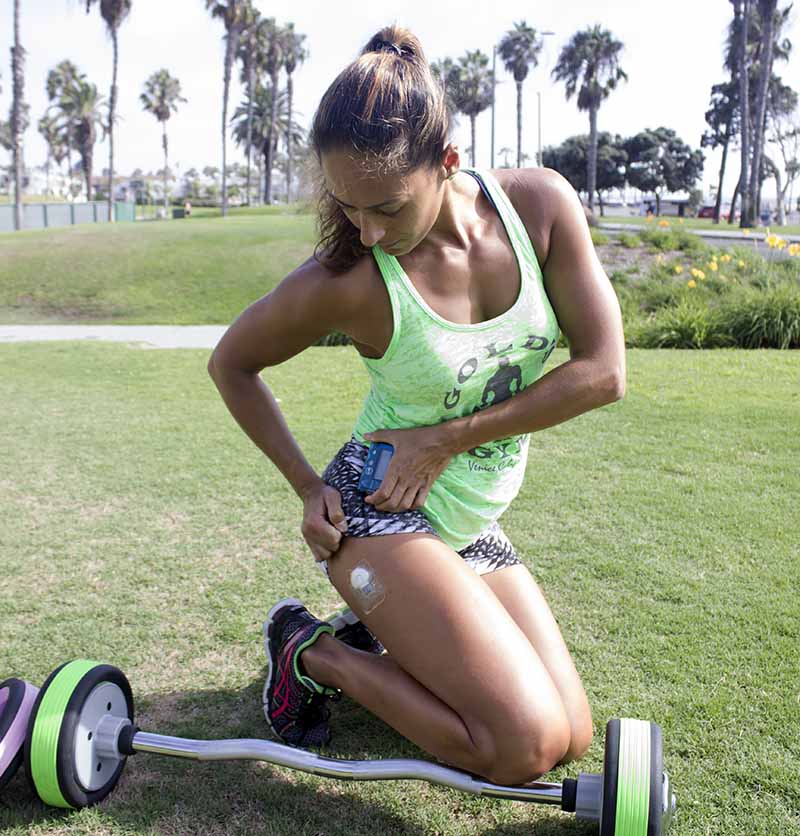You’ve probably seen me wearing a small device on my upper arm in a lot of the pictures on this website. That’s my continuous glucose monitor (CGM), a tool that’s instrumental in my daily diabetes management.
It’s a brilliant piece of equipment, and I absolutely love it (most of the time).

What is CGM?
A CGM device makes it possible for me to see my glucose readings in (almost) real-time and to track historical glucose data.
Most CGMs include three main components:
- A small sensor that is inserted just under the skin (where it reads glucose levels in interstitial fluid, or the fluid between body cells)
- An attached transmitter (this is the part you see on my arm), which sends the readings to a receiving device
- A receiver or smartphone that displays the readings and glucose trend data
There are currently several CGM systems available for personal use in the United States:
- Abbott FreeStyle Libre 2
- Abbott FreeStyle Libre 3
- Ascensia Diabetes Care Eversense E3 (a fully implantable option)
- Dexcom G6
- Dexcom G7
- Medtronic Guardian Connect
My experience with CGM
I got my first Medtronic CGM in December 2012 and wore it every day for 18 months before taking a break. I then ordered my first Dexcom system in August 2016, and that has been my go-to since.
There are pros and cons to all CGM systems. Since I’ve only worn Medtronic and Dexcom devices to date, I’ll give you my opinions based on those so you can decide if a CGM might help you manage your diabetes better.
The advantages of CGM
Data
If you do finger-stick blood sugar checks and know your body well, you probably think you have a pretty good idea of what your sugars are up to between measurements. Chances are good, though, that you may be wrong.
I got a big surprise when I started seeing how much my blood sugar actually varied throughout the day, not to mention during the night when I usually don’t check.
CGM is a vital tool for providing this type of ongoing information over a 24-hour period that can show trends and patterns, as opposed to the snapshots at certain times during the day that are provided by traditional monitoring.
All of a sudden, I could see how certain foods and activities affected my glucose levels over the next several hours. That information is golden!
Plus, being able to spot low sugars before they hit (thanks to the alerts I set for when my sugar levels start dropping or get to a certain point) has really cut down on how often I have low blood sugar episodes.
It also means I’m consuming fewer glucose tablets and less juice to deal with said lows, because I’m catching them earlier when less intervention is required to get my blood sugar back to target range.
Management
So, what to do with all this new information? In my case, it has not only helped me limit episodes of hypoglycemia (low blood sugar), but I have also managed to reduce my A1c level (a measure of glucose control over the previous 2 to 3 months) to around 6.0 percent.
My blood sugar has always been pretty well-regulated but has never been this stable before.
What’s more, some current CGM devices can integrate with an insulin pump, allowing you to monitor both glucose and insulin levels at the same time.
And certain devices combine CGM and insulin pump technology with an algorithm that automatically adjusts insulin dosing to help glucose stay within target range (the optimal level as determined by a person’s healthcare provider), in an innovation known as hybrid-closed loop (HCL) technology.
Current HCL devices on the market include:
- Medtronic MiniMed 770G
- Medtronic MiniMed 780G
- t:slim X2 Insulin Pump with Control-IQ Technology + Dexcom G6/G7
- Insulet Omnipod 5
Of course, just slapping on a CGM won’t manage your diabetes. But careful interpretation and use of the data can help immensely.
For instance, I’ve learned that if I sleep any later than 8 a.m. before taking my morning insulin, I’ll be battling high morning blood sugar levels until at least noon.
I’ve also learned what kind of activities will make my sugars drop fast (in my case, that would be walking), my true levels of insulin sensitivity throughout the day, and that I always need a minimum of a half unit of active insulin on board (IOB) before a workout.
Gaining this knowledge took time and did include a few missteps, but that’s life and that’s learning. The information has made it possible for me to optimize my training and has made it easier for me to stay in my desired range of 90 to 144 mg/dL (5.0 to 8.0 mmol/L) when exercising.
Confidence and security
My CGM has enabled me to understand my diabetes better. It has given me more confidence in the way I manage my condition and has helped me achieve tangible results.
It’s also comforting to know how my sugar levels are trending. I will even venture out sometimes without bringing all my diabetes gear. I also stopped monitoring 10 to 12 times a day because I no longer need to — the information is always right there on the screen in front of me.
Using this device has enabled me to go for a walk or a hardcore gym session without fearing lows and to reach both my fitness and diabetes health goals more efficiently.

The disadvantages of CGM
Accuracy
Anybody who has ever worn a CGM knows the frustration of doing a traditional finger-stick check and seeing that the sensor reading is off.
The reason behind this is that the technology isn’t perfect yet (although it is constantly improving) and the sensor measures your glucose levels in the interstitial fluid and not the blood. (There is generally a lag of a few minutes between your interstitial glucose levels and blood glucose levels)
Aside from the obvious issues, it can also be outright dangerous if you rely solely on the sensor readings and completely ignore what your body is telling you. For example, if the CGM alarms are going off telling you that you are at 250 mg/dL (13.9 mmol/L), it can be hard not to immediately react.
I have also had to stop workouts because the sensor incorrectly told me that my blood glucose was low or about to get low — always an annoying scenario when you’re in the midst of a good gym session.
Although some CGM devices are now highly accurate and approved by the U.S. Food and Drug Administration (FDA) for making treatment decisions, it is always wise to confirm any unexpected readings or readings that don’t match what your body is feeling with a traditional finger-stick before taking action.
(And several of the devices on the market, including the Medtronic Guardian and the Ascensia Eversense E3, require roughly two finger-stick checks a day for calibration.)
That said, it’s worth noting that the technology has improved tremendously over the years. According to a 2023 study, CGMs were shown to be 96.5 percent accurate in a real-world hospital setting.
Overreliance
This is actually the main reason why I originally stopped wearing my CGM and why I still take breaks on occasion.
This may not apply to everyone, but I have a tendency to rely on the readings and recommendations a bit too heavily. For example, if the reading said that my glucose was dropping quickly, I would trust it fully over how I actually feel. I think that’s a big no-no when it comes to diabetes management. In this scenario, it would be prudent to confirm the CGM information with a finger-stick check.
I have gotten a lot better at using the CGM as a data point and not necessarily as the complete truth, which has made it a far better partner in management.
Inconvenience
Having the CGM sensor attached to my body all the time can be extremely annoying. It’s not very big and people don’t really notice it, but it can leave somewhat unattractive suntan marks, and I also tend to scar easily.
If I wear it on my stomach, it tends to get in the way when working out, so I usually wear it on my upper arm. I find that I get pretty good readings with that placement. (One issue, though, is that it can be a little hard to get a sweaty sports bra off without ripping at the sensor.)
Wearing it on my upper arm has led to some pretty cool interactions and conversations with curious people. I don’t mind — I see it as an opportunity to educate and advocate.
But if it bothers you, there are plenty of other areas to place the sensor where it’s not visible. Typical manufacturers’ recommendations for sensor placement include the upper arm, stomach, lower back, thigh, and buttocks, depending on the specific device you’re using.
There are adhesives that can help strengthen the CGM’s adherence to your body. Refer to the instructions that come with your CGM and speak with your diabetes care provider about approaches that can work for you.
On a related topic, many people wonder if CGMs hurt. In my experience, there is only a slight pinching sensation upon inserting the sensor, and this momentary discomfort is well worth the data the device provides.
Plus, for the devices currently on the market, the sensors only need to be changed every 7 to 10 days (with the exception of the implantable Eversense E3, which typically needs to be changed by a healthcare provider every 90 days).
Related: Here is a post outlining my best CGM tips in which I talk more about how to put on the sensor (with a video) and how to make it stay on.
Price
Depending on your health insurance coverage, CGM devices and their associated supplies can be expensive. Check with your insurance provider to determine what costs are associated with CGM for you.

Final thoughts
Would I recommend a CGM to anyone with diabetes using insulin? The answer is a resounding yes, at least until you understand your body and your diabetes better.
The CGM will give you knowledge about your diabetes that you have never had before, and if after a while you feel like you no longer need it, speak with your diabetes care provider about other options.
The key for me when using my CGM is to get better at listening to both the CGM and my body. It’s a fantastic device, but it’s not a substitute for my own thinking and experience.
It’s a great tool to have in my diabetes toolbox, but it can’t stand alone.





Mike Eischen
Hey Christel,
What an awesome piece of journalism. I genuinely enjoy all your articles and really thought this one was chock full of useful information regarding CGM’s. I have been a CGM user since 2017. I too have had a few different versions that I have tried. I started with Dexcom, tried Freestyle and am currently a dedicated Eversense user. Dexcom worked well, and I had a valuable experience with it. I did not like the Freestyle because, as you mentioned, you had to scan it to get a reading. It is not real-time like the others. I also found positioning the Freestyle sensor on the back of my arm as recommended inconvenient as I would frequently run into things, and it would tear the sensor off, which would waste a sensor. I did not try any other locations for the sensor. With Eversense, if it gets ripped off, I simply need to reapply it. IMHO, I think Eversense is one of the best ones out there. Also, a small update, you can now get an implanted sensor that only needs to be replaced every 6 months (soon to be approved for a year). When I considered the choice of switching from Dexcom to Eversense, I weighed all the advantages and disadvantages. I chose Eversense, even though it needs a daily fingerstick to calibrate (sometime 2 per day), but I like being able to remove the transmitter when I need to. I am little more self-conscious when I am wearing it and until recently wasn’t prepared for questions like “what is that thing.” Lately, I have changed my tune and willingly educate people on what a CGM is and what it is used for. The only downside of Eversense is indeed the insertion process. I have been using it now for 4 years and am used to it. I don’t mind the need to calibrate it. That helps me know that the readings are accurate.
Keep up the good work and I look forward to your next article.
Andrew Diseker
I use the FreeStyle 3 and I’ve had constant problems with the sensor reporting 30 to 50 points lower than the actual value from the finger stick, this usually starts out accurate but after about 2 or 3 days the values drop off, and the low glucose alarm starts going off constantly, reading in the 50s when finger stick shows 90s. Occasionally I’ll get a good sensor that lasts a full 2 week period, but most of the time it will start failing. Even the few times I report it, the replacement fails, sometimes fails right off the bat. There’s no way to calibrate the FreeStyle 3 that I can find, which I think is just wrong, there should be some way to bring it in line with reality. I don’t recommend it.
Attilio
My experiences with CGM show that it’s better to have no information than bad information. The truth is that if you want to check your sugar all you need to do is perform a fingerstick.
I got one of the first CGM’s maybe 15 years ago and it was EXTREMELY painful, highly inaccurate, and worst of all would constantly give (False) alarms, need constant calibration, keep me up all night with sugar alarms that were flat our wrong based on inaccurate readings.
I just tried another last week based on all the hype; the *ONLY* difference is the new ones are not painful.
Keep checking your sugar 6-8x a day or more. It’s still the only way. These CGM’s are overpriced junk made to be sold, not bought.
Chris
This has been my experience as well. What’s the point of having “continuous monitoring” when no meaningful, dependable data can be relied on? The inaccuracy of CGMs blows my mind, I am T2 and I wouldn’t trust them to make simple meal decisions, let alone use insulin. Every 3-4 years I give them another try and they’re still useless garbage. On my latest attempt the freestyle libre was giving me 3,9 mmol (70 mg) while I was actually at 8,2 (147) ! I wouldn’t trust those toys on a diabetic stray pigeon.
jane
My daughter just started using the dexcom. she has a seizure disorder and we have seen in just a week, her seizures increase. i would like to know if you have any information on seizures and the dexcom.
Christel Oerum
If the two are linked it would be considered a severe adverse event. I’ve never heard of that before, but if you haven’t already please contact Dexcom so that it can be recorded and reported to the right authorities
Rhapsodie
Jane, sorry I’m horrid at answering emails,
My diabetes started when I was 5, my mom was adjusting my insulin repeatedly, initially with calling the doctors all the time. My first low sugar attack resulted in a seizure, but I’ve had them continue with lows. The diabetes mellititus causing the lows was because of insulin uses. Other seizure types which have different treatments aren’t from diabetes.
For your daughter if it’s the insulin uses, then the adjustments are going to be considerable through her life. AND the CGM which is a monitor for insulin values will be based on the target ranges and how you adjust the insulin based on the type of insulin in use.
For me the insulin adjusting uses the graph on the 670g. My insulin is a 3 hour type, which means I’m going to adjust based on the ups OR downs and a half hour before I see the change in my graph. Use of YooHoo & Vanilla nutrition plus to care for the lows when they are really low, and use of lowering with the temporary basals if I’m not going to intake a carb.
The seizures are generally from lows under 40, but any low under 55 is bad enough. The food I eat impacts the sugar values and insulin uses, for example if I’m eating a beef n bean burrito, I take a square bolus for 1.5 hours because the food digests slower than the insulin works. If I have pizza, then it’s a dual bolus depending on the carb of the pizza, here in the North East it’s white flour, so it’s a 50% immediate insulin and 50% square wave insulin for 6 to 8 hours normally depending on what’s on the pizza.
All foods have different starch, protein, and fat values, so I have different insulin needs for different food types. There are also different insulin adjustment needs for types of activities. So with work there are lower insulin amounts used than with sleep or TV watching which are higher amounts. This is also true with types of work, if I’m gardening my rates are lower than if I’m sewing, so activities impact insulin rates also.
Use of the temporary basal rates with the insulin pump allow adjusting for activity that’s of a rate higher than normal OR even lower than normal. Insulin amounts go up for lower than normal activities, and go down for higher than normal activities. Since I’ve been adjusting my insulin for my whole life I continue to do so because my doctors are likely to respond in 12 to 36 hours, I need to adjust now.
Your daughter and you are living with the diabetes 24 hours a day 7 days a week, your doctor is available generally 8 hours only 5 days a week…so you both need to take care of the insulin adjustments and your actions with the sugar. In 10 years you and your daughter are still going to be living with the diabetes, but your doctor is likely to be somewhere else not dealing with your issues OR your health concerns anymore.
Chris
I have a good friend that i have known since High School who has seizures since a baby. One trigger that I thought was odd was using any type of power tool in school. Now granted that was over 25 years ago, however after talking to both him abd his dad, it almost seemed like powered equipment or devices were one of the many triggers for him then. If i was experiencing what your daughter is or my child was experiencing this problem, id take itoff for a week or 2 and see what happens. Just my suggestion.
Sharon
Hi my daughter is 4 years old and she was diagnosed last year with type 1. As we are new to this life style do you think it is a good idea to use a CGM for her. What other tips can you give me to help us.
Christel Oerum
Dexcom is approved for kids ages 2 and up and yes I think it would make your life so much easier. It can allow you to become more proactive in her care, especially if she can’t quite communicate if she’s going high or low.
You can also get her blood sugar readings on your photos (through the share functionality) so even if you’re not with her you can still see her readings.
Rhapsodie
For Jane & Sharon, and others,
For any low sugar treatments there are variations of treatment options. When considering those your life styles and the ability to treat the lows will shift. Some of the best treatments against the low sugars involve protein. The simple sugar drinks and sugar tablets have no protein or fat and aren’t good for continuing activities until after real food is ingested. White flour, sugar, corn syrup, and other sugar ingestion’s will work fast, but aren’t going to stick with the body, so additional care is needed. Like taking less insulin OR adding protein and fat with uses to keep the carb digesting as long as the insulin is working.
– Milk is a great treatment, it takes between 10 to 15 minutes to work against a low, but it stays in your system, so no other treatment is necessary unless there’s active insulin for a food that had a different carb OR type variation than you need now.
-Walmart sells the Nutrition Plus drinks, they are 350 calories, contain soy, protein, and lots of carb. 1/5th of a container has 10 carbs, it works great being a quick swallow, but after opening the containers, like the milk, should be refrigerated. I prefer to refrigerate mine anyway, so the fridge is a normal place I go to get a treatment.
-YooHoos are chocolate flavored, with no caffeine, they are technically said to be 20 carbs, but they digest like 10 carbs because they are a corn syrup sugar. They have no protein, so other protein/fat is needed for better longer term results. They are also really nice because they are sealed until opened, and have a straw which makes it easier during an attack to suck down.
-The straw, for any low sugar episode, previous to the seizures which are at lower ranges, the straw is very useful because an individual doesn’t have to aim, hold up, or adjust angle with trying to get a drink.
The drinks are better because they are more easily absorbed by the body for low sugar. BUT there are also other things that can be useful, like prepared child packs with the suck spouts which can be refilled, so a variation of treatments can be made for uses. AND there are the options like peanut butter and jelly packets, which can be kept in pockets OR purses with the sugar jelly and fatty/protein peanut butter for holding the carb in the body longer.
The protein/fat combinations have various potentials and values also. A chicken, venison, fish, almond, walnut protein low in fat is like a simple carbohydrate it doesn’t stay in the body long enough to carry the carb value forward for the length of insulin used for a carb food. BUT those can be fine if the insulin is adjusted with the carb to keep lows from happening. Beef, bacon, pork, and other foods with the fattier red meats are likely to take longer to digest, so they compliment a carb okay, but in some cases, like the burritos the insulin needs to be extended to keep it working correctly with the food.
Fiber also impacts things, this is on top of what other foods are combined OR not.
Toast- For a whole wheat bread I still cut the insulin use to 2/3rds with the carb, so a slice of good whole wheat bread at 23carbs, I take 16 carbs of insulin. BUT a white slice of bread with 11 carbs I use 50%, 1/2, the insulin so instead of 11 carbs I take 5. This adjustment with the white bread means my sugar goes high earlier in the insulin use, but over the use, through the 3 hours it goes back down to normal. With the wheat bread which is digested through the 3 hours I don’t have lows OR highs.
Sandwich- A peanut butter and jelly sandwich with either the white bread OR the whole wheat bread would have me taking the same bread insulin as mentioned above. BUT I would also add in 1/2 the insulin for the jelly, jam, OR preserves unless that was sugar free. And I would add in all the insulin for the peanut butter, if it had any carbs. BUT it also means measuring the amounts of food being used. If I only use 1.5 teaspoons of peanut butter and a serving is 2 tablespoons, then I’ve only taken 1/4 the amount of the whole serving.
Food measuring and more is always a factor using carbohydrates. Any manufactured product could have accurate measures, but they may not. Any homemade item with the ingredients put in can be added to a recipe card that allows you to know what has gone into it and then divide based on portions to know what the adjustments are coming out of uses.
Fruits and vegetables, in some calorie manuals and books list information, for most of those the carbs are wrong with fruits and vegetables. The potatoes, lima beans, dry beans, prepackaged fruits, and other dried veggies are likely to be better in starch listings. Other starches vary a lot with the freshness, type, and sizes of the fruits and veggies. The sugar amounts with vegetables and fruits are also varied because of fiber amounts and how long the digestion through those foods is with the body. For example, with a serving of grapes I take 75% of the carb, but with a serving of apple I take 50% of the carb.
So the insulin factors and uses mean constant diet care and more for better health. I’m 47, my A1C levels are at between 5.8 and 6.0, so it’s a constant struggle, but my doctors have found no issues with my organs, eyes, or limbs that are diabetes related.
Marlies
I’ve been wearing the 670G cgm for over 1 1/2 years. The new sensors are a huge improvement over the previous model. I absolutely love this pump and cgm. I have great sensor accuracy and vastly improved HA1C results. Each system has its drawbacks but many issues can be traced to personal behavior. Wearing any pump involves being a very active participant. Learning to count carbs accurately and knowing how your body reacts to them at different parts of the day is really key. Learning when to calibrate and where to place sensors for the best accuracy is also vital. It is just so complicated when we all want it to be easy. I hope the 780G improves on some of the issues most frustrating to us. One thing I do know is that I can’t imagine not having it.
Barbara
I wear a Medtronic 670g pump and i wear there cgm sensors i find the alarms to be annoying. Seems like every time i turn around it is telling me to do something .
Christel Oerum
I’ve heard that feedback from a few who wears the 670G. It’s something I hope they can address with their next model because that must be annoying
Alexis
I use a Medtronic 670G pump, very impressed with the accuracy of the CGM, however, when I switched to Medicare from my private insurance, Medicare did not cover the sensor supplies. I realized very soon that I did not want to go back to multiple daily finger sticks. After some research and many phone calls, Medicare covers 100% of the costs of the Dexcom G6. I Love it, it is very accurate, and get the readings on my phone. It does not connect to my pump, but it is important for me to get alerts if I go low at night since I live alone. I never want to be without a CGM.
Christel Oerum
It’s so crazy to me that they don’t cover the sensor when the 670G functionalities don’t work without it. Once your pump is up for renewal you can consider switching o the Tandem pump. Their closed-loop system works with Dexcom
Deb
Ditto on all of that
Laura
Hi I am type 2 diabetic can u wear one of those things on your arm or leg for type 2 or not?
Christel Oerum
Some insurance companies (US specifically) have restrictions when it comes to reimbursement for people living with type 2 diabetes but it’s worth having a discussion with your doctor. If you don’t use insulin you might get enough benefit from using a Libre Freestyle, which is more of a finger stick replacement than a CGM but it will give you more data, and no more finger sticks
Bob
Great article. I am 45 days into my Dexcom G6, I love it. I tried the Eversense, but it is not ready for prime time at all. The insertion and removal process are painful to me. And well, the app dropped like 20-30 times a day. Dex for life.
Reg Munro
I’ve been diabetic since an accident back in 1965 (yes 56 years ago). I started using DEXCOM G6 earlier this year and it has been transforming!
My wife is an expert on the Banting way of eating and this smooths our my CGM charts amazingly. We are hitting very close to 100% time in range.
My ingest issue is still dealing with lows (under 5) and we’re still looking for quick correctives that don’t send bg crazy high. Any thoughts?
I use a teaspoon of honey and almond paste mix as the bg holder up for when I go for an energetic walk. Reg Vape Town
Christel Oerum
If you’re looking to raise your blood sugars quickly I’d suggest you skip the almond paste. Fat slows down digestion and thereby how fast blood sugars get back into range. I like glucose tablets as they are super easy to dose accurately. Since you’re low carb you might only need 1 tablet (5 grams) to get back into range…quickly